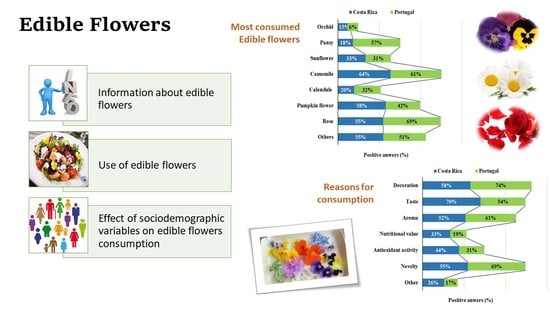Edible Flowers, Old Tradition or New Gastronomic Trend: A First Look at Consumption in Portugal versus Costa Rica
Abstract
1. Introduction
2. Materials and Methods
2.1. Data Collection and Sample Characterization
2.2. Data Analysis
3. Results and Discussion
3.1. Information about Edible Flowers
3.2. Use of Edible Flowers
3.3. Effect of Sociodemographic Variables in Edible Flowers’ Consumption
4. Conclusions
Author Contributions
Funding
Acknowledgments
Conflicts of Interest
References
- Mlcek, J.; Rop, O. Fresh edible flowers of ornamental plants—A new source of nutraceutical foods. Trends Food Sci. Technol. 2011, 22, 561–569. [Google Scholar] [CrossRef]
- Takahashi, J.A.; Rezende, F.A.G.G.; Moura, M.A.F.; Dominguete, L.C.B.; Sande, D. Edible flowers: Bioactive profile and its potential to be used in food development. Food Res. Int. 2020, 129, 108868. [Google Scholar] [CrossRef]
- Vinokur, Y.; Rodov, V.; Reznick, N.; Goldman, G.; Horev, B.; Umiel, N.; Friedman, H. Rose Petal Tea as an Antioxidant-rich Beverage: Cultivar Effects. J. Food Sci. 2006, 71, S42–S47. [Google Scholar] [CrossRef]
- Chen, N.-H.; Wei, S. Factors influencing consumers’ attitudes towards the consumption of edible flowers. Food Qual. Prefer. 2017, 56, 93–100. [Google Scholar] [CrossRef]
- Guiné, R.; Florença, S.G.; Ferrão, A.C.; Correia, P.M. Investigation about the consumption of edible flowers in Portugal. Indian J. Tradit. Knowl. (IJTK) 2019, 18, 579–588. [Google Scholar]
- Fernandes, L.; Casal, S.; Pereira, J.A.; Saraiva, J.A.; Ramalhosa, E. Edible flowers: A review of the nutritional, antioxidant, antimicrobial properties and effects on human health. J. Food Compos. Anal. 2017, 60, 38–50. [Google Scholar] [CrossRef]
- Guiné, R.P.F.; Pedro, A.; Matos, J.; Barracosa, P.; Nunes, C.; Gonçalves, F.J. Evaluation of phenolic compounds composition, antioxidant activity and bioavailability of phenols in dried thistle flower. Food Meas. 2017, 11, 192–203. [Google Scholar] [CrossRef]
- Kucekova, Z.; Mlcek, J.; Humpolicek, P.; Rop, O.; Valasek, P.; Saha, P. Phenolic compounds from Allium schoenoprasum, Tragopogon pratensis and Rumex acetosa and their antiproliferative effects. Molecules 2011, 16, 9207–9217. [Google Scholar] [CrossRef]
- Nowak, R.; Olech, M.; Pecio, L.; Oleszek, W.; Los, R.; Malm, A.; Rzymowska, J. Cytotoxic, antioxidant, antimicrobial properties and chemical composition of rose petals. J. Sci. Food Agric. 2014, 94, 560–567. [Google Scholar] [CrossRef]
- Skowyra, M.; Calvo, M.; Gallego, M.; Azman, N.; Almajano, M. Characterization of Phytochemicals in Petals of Different Colours from Viola × wittrockiana Gams and Their Correlation with Antioxidant Activity. J. Agric. Sci. 2014, 6, 93–105. [Google Scholar] [CrossRef]
- Biondi, B.; Van der Lans, I.A.; Mazzocchi, M.; Fischer, A.R.H.; Van Trijp, H.C.M.; Camanzi, L. Modelling consumer choice through the random regret minimization model: An application in the food domain. Food Qual. Prefer. 2019, 73, 97–109. [Google Scholar] [CrossRef]
- O’Connor, E.L.; Sims, L.; White, K. Ethical food choices: Examining people’s Fair Trade purchasing decisions. Food Qual. Prefer. 2017, 60, 105–112. [Google Scholar] [CrossRef]
- Reddy, G.; van Dam, R.M. Food, culture, and identity in multicultural societies: Insights from Singapore. Appetite 2020, 149, 104633. [Google Scholar] [CrossRef] [PubMed]
- Risso, D.S.; Giuliani, C.; Antinucci, M.; Morini, G.; Garagnani, P.; Tofanelli, S.; Luiselli, D. A bio-cultural approach to the study of food choice: The contribution of taste genetics, population and culture. Appetite 2017, 114, 240–247. [Google Scholar] [CrossRef] [PubMed]
- Sirasa, F.; Mitchell, L.; Silva, R.; Harris, N. Factors influencing the food choices of urban Sri Lankan preschool children: Focus groups with parents and caregivers. Appetite 2020, 150, 104649. [Google Scholar] [CrossRef]
- Zoltak, M.J.; Veling, H.; Chen, Z.; Holland, R.W. Attention! Can choices for low value food over high value food be trained? Appetite 2018, 124, 124–132. [Google Scholar] [CrossRef]
- Rop, O.; Mlcek, J.; Jurikova, T.; Neugebauerova, J.; Vabkova, J. Edible flowers—A new promising source of mineral elements in human nutrition. Molecules 2012, 17, 6672–6683. [Google Scholar] [CrossRef]
- Hill, M.M.; Hill, A. Investigação por Questionário, 2nd ed.; Sílabo: Lisboa, Portugal, 2008. [Google Scholar]
- Marôco, J. Análise Estatística com o SPSS Statistics, 7th ed.; Report Number: Lisboa, Portugal, 2018. [Google Scholar]
- Robinson, O.C. Sampling in Interview-Based Qualitative Research: A Theoretical and Practical Guide. Qual. Res. Psychol. 2014, 11, 25–41. [Google Scholar] [CrossRef]
- Bornstein, M.H.; Jager, J.; Putnick, D.L. Sampling in developmental science: Situations, shortcomings, solutions, and standards. Dev. Rev. 2013, 33, 357–370. [Google Scholar] [CrossRef]
- Witten, R.; Witte, J. Statistics, 9th ed.; Wiley: Hoboken, NJ, USA, 2009. [Google Scholar]
- Moore, M.K. Chapter 4—Sex Estimation and Assessment. In Research Methods in Human Skeletal Biology; DiGangi, E.A., Moore, M.K., Eds.; Academic Press: New York, NY, USA, 2013; pp. 91–116. ISBN 978-0-12-385189-5. [Google Scholar]
- Kaisoon, O.; Siriamornpun, S.; Weerapreeyakul, N.; Meeso, N. Phenolic compounds and antioxidant activities of edible flowers from Thailand. J. Funct. Foods 2011, 3, 88–99. [Google Scholar] [CrossRef]
- Rodrigues, H.; Cielo, D.P.; Goméz-Corona, C.; Silveira, A.A.S.; Marchesan, T.A.; Galmarini, M.V.; Richards, N.S.P.S. Eating flowers? Exploring attitudes and consumers’ representation of edible flowers. Food Res. Int. 2017, 100, 227–234. [Google Scholar] [CrossRef] [PubMed]
- Pires, T.C.S.P.; Barros, L.; Santos-Buelga, C.; Ferreira, I.C.F.R. Edible flowers: Emerging components in the diet. Trends Food Sci. Technol. 2019, 93, 244–258. [Google Scholar] [CrossRef]
- Cunningham, E. What Nutritional Contribution Do Edible Flowers Make? J. Acad. Nutr. Diet. 2015, 115, 856. [Google Scholar] [CrossRef]
- Shi, J.; Gong, J.; Liu, J.; Wu, X.; Zhang, Y. Antioxidant capacity of extract from edible flowers of Prunus mume in China and its active components. LWT Food Sci. Technol. 2009, 42, 477–482. [Google Scholar] [CrossRef]
- Scotter, M.J. 6—Methods of analysis for food colour additive quality and safety assessment. In Colour Additives for Foods and Beverages; Scotter, M.J., Ed.; Woodhead Publishing Series in Food Science, Technology and Nutrition; Woodhead Publishing: Oxford, UK, 2015; pp. 131–188. ISBN 978-1-78242-011-8. [Google Scholar]
- Matyjaszczyk, E.; Śmiechowska, M. Edible flowers. Benefits and risks pertaining to their consumption. Trends Food Sci. Technol. 2019, 91, 670–674. [Google Scholar] [CrossRef]
- Chen, G.-L.; Chen, S.-G.; Xie, Y.-Q.; Chen, F.; Zhao, Y.-Y.; Luo, C.-X.; Gao, Y.-Q. Total phenolic, flavonoid and antioxidant activity of 23 edible flowers subjected to in vitro digestion. J. Funct. Foods 2015, 17, 243–259. [Google Scholar] [CrossRef]
- Pires, T.C.S.P.; Dias, M.I.; Barros, L.; Calhelha, R.C.; Alves, M.J.; Oliveira, M.B.P.P.; Santos-Buelga, C.; Ferreira, I.C.F.R. Edible flowers as sources of phenolic compounds with bioactive potential. Food Res. Int. 2018, 105, 580–588. [Google Scholar] [CrossRef]
- Benvenuti, S.; Bortolotti, E.; Maggini, R. Antioxidant power, anthocyanin content and organoleptic performance of edible flowers. Sci. Hortic. 2016, 199, 170–177. [Google Scholar] [CrossRef]
- Villavicencio, A.L.C.H.; Heleno, S.A.; Calhelha, R.C.; Santos-Buelga, C.; Barros, L.; Ferreira, I.C.F.R. The influence of electron beam radiation in the nutritional value, chemical composition and bioactivities of edible flowers of Bauhinia variegata L. var. candida alba Buch.-Ham from Brazil. Food Chem. 2018, 241, 163–170. [Google Scholar] [CrossRef]
- Egebjerg, M.M.; Olesen, P.T.; Eriksen, F.D.; Ravn-Haren, G.; Bredsdorff, L.; Pilegaard, K. Are wild and cultivated flowers served in restaurants or sold by local producers in Denmark safe for the consumer? Food Chem. Toxicol. 2018, 120, 129–142. [Google Scholar] [CrossRef]
- Lightner, M.; Rand, S. The enhancement of natural colors to provoke seasonality. Int. J. Gastron. Food Sci. 2014, 2, 55–59. [Google Scholar] [CrossRef]
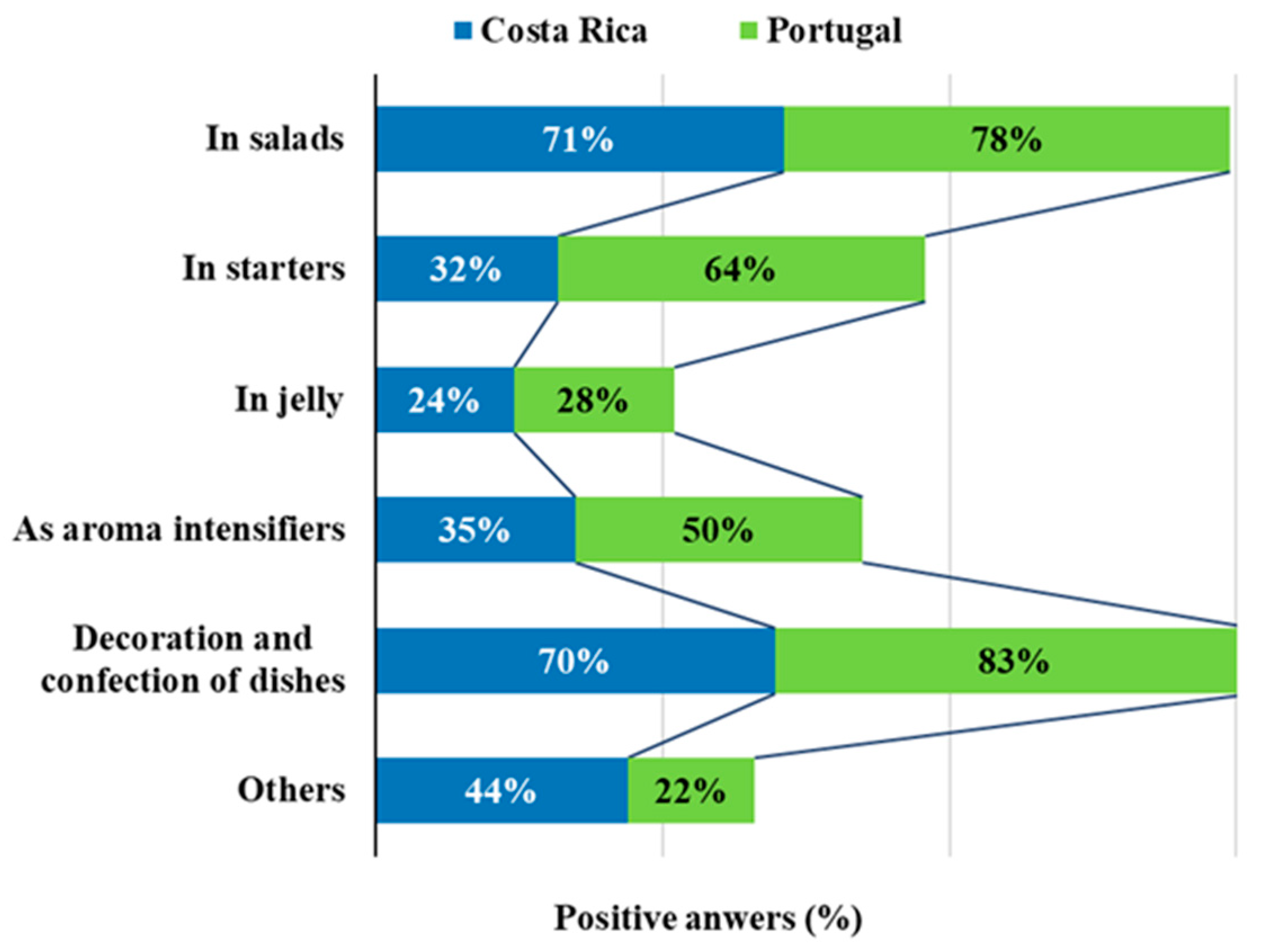
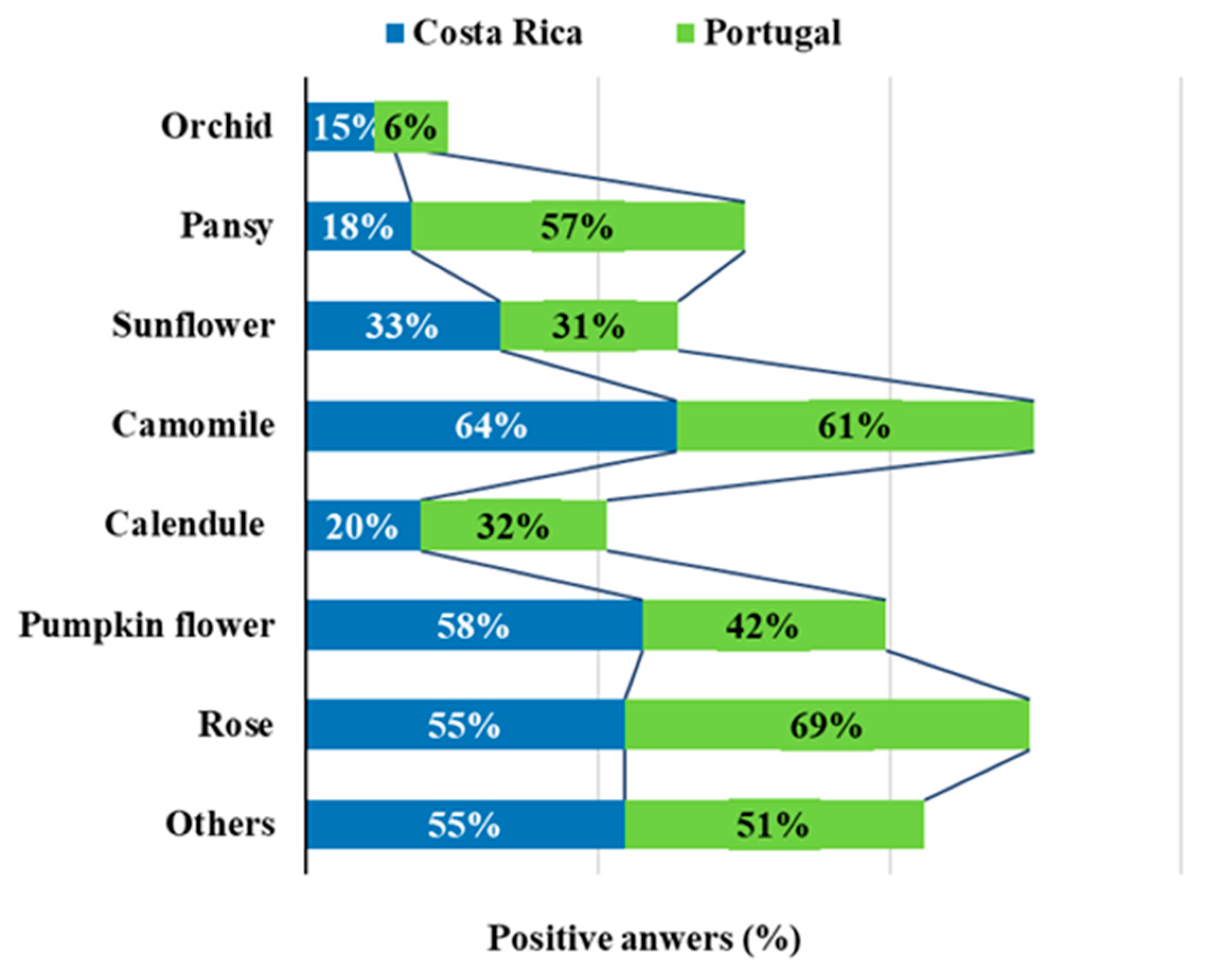
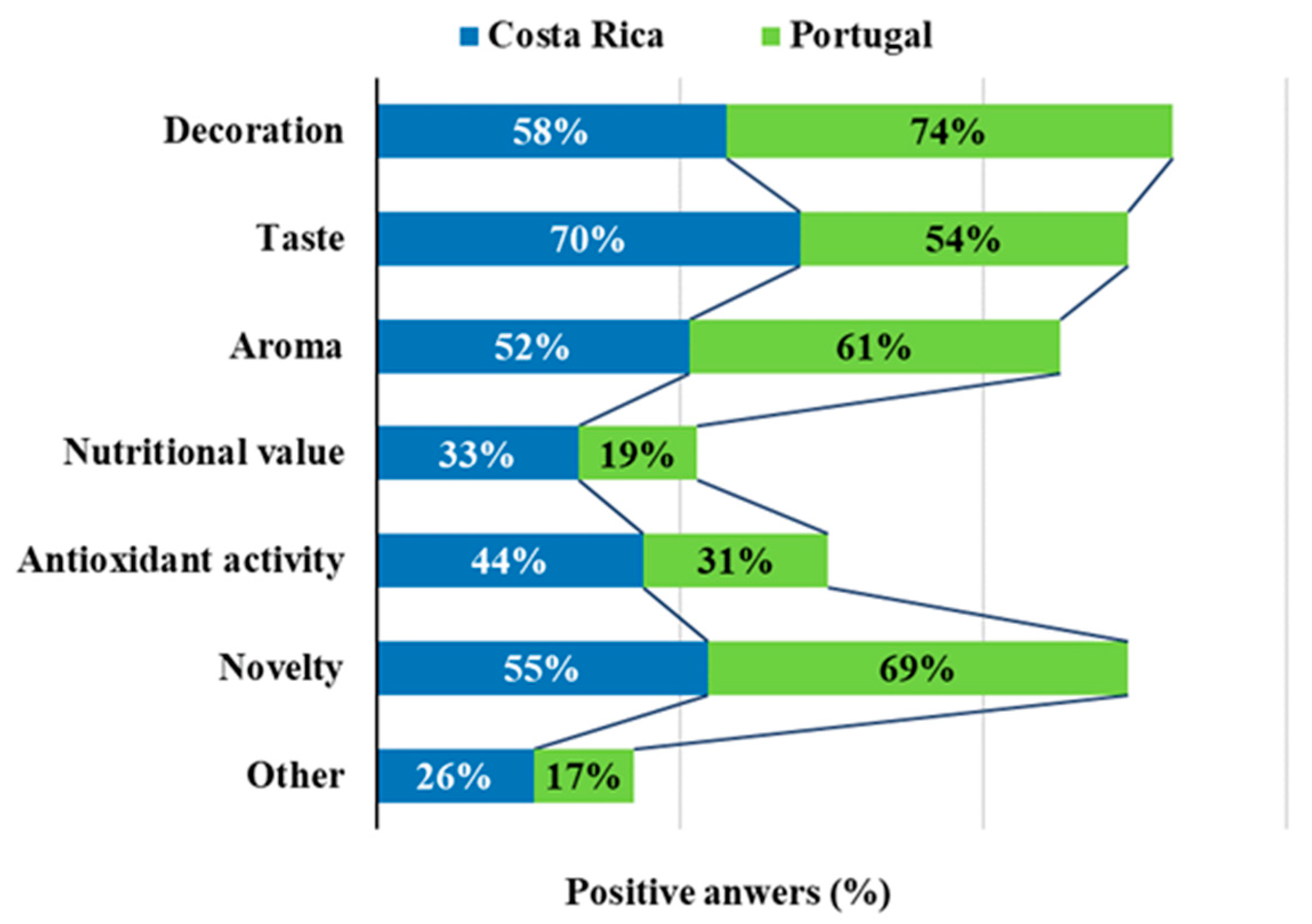
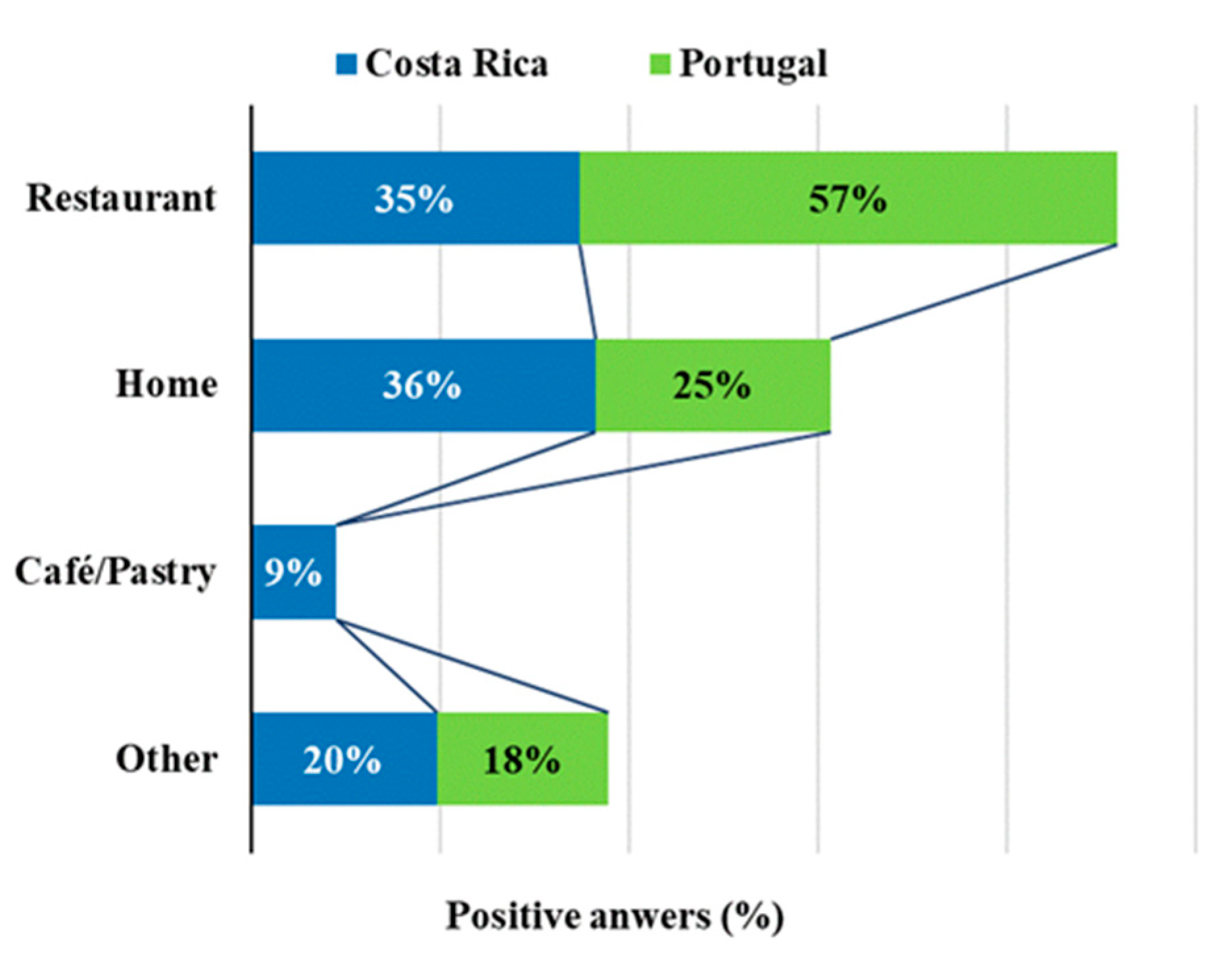
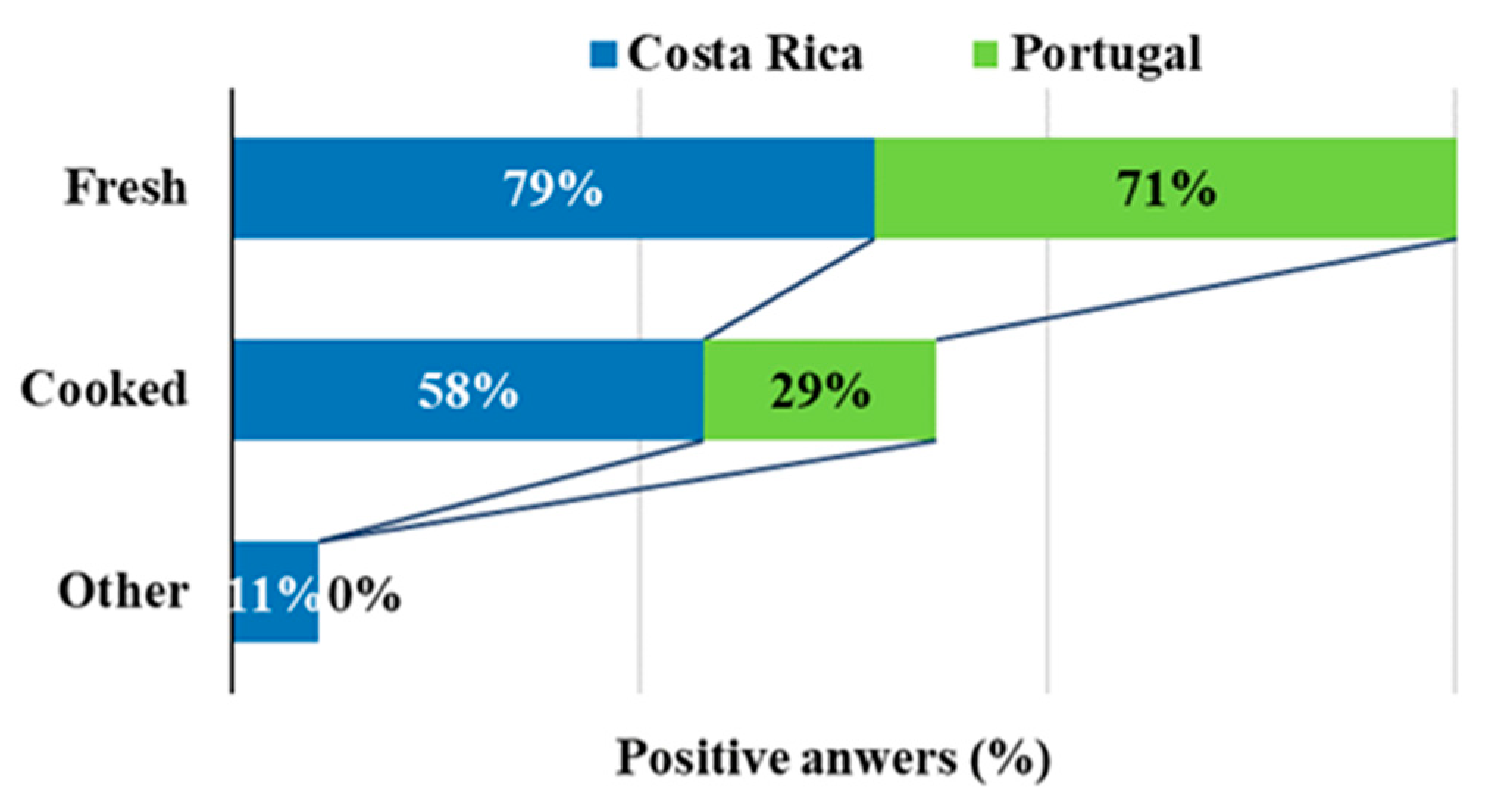
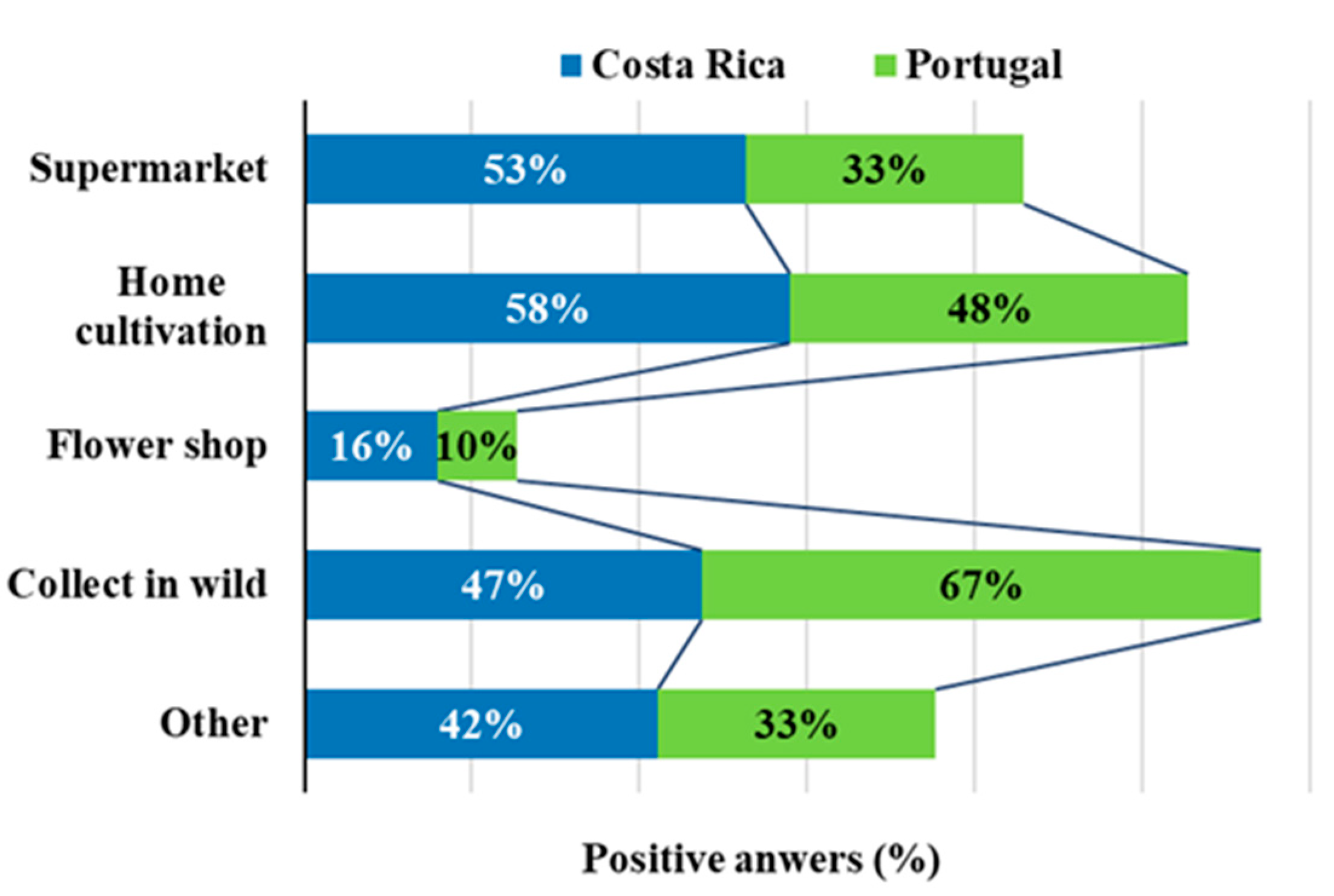
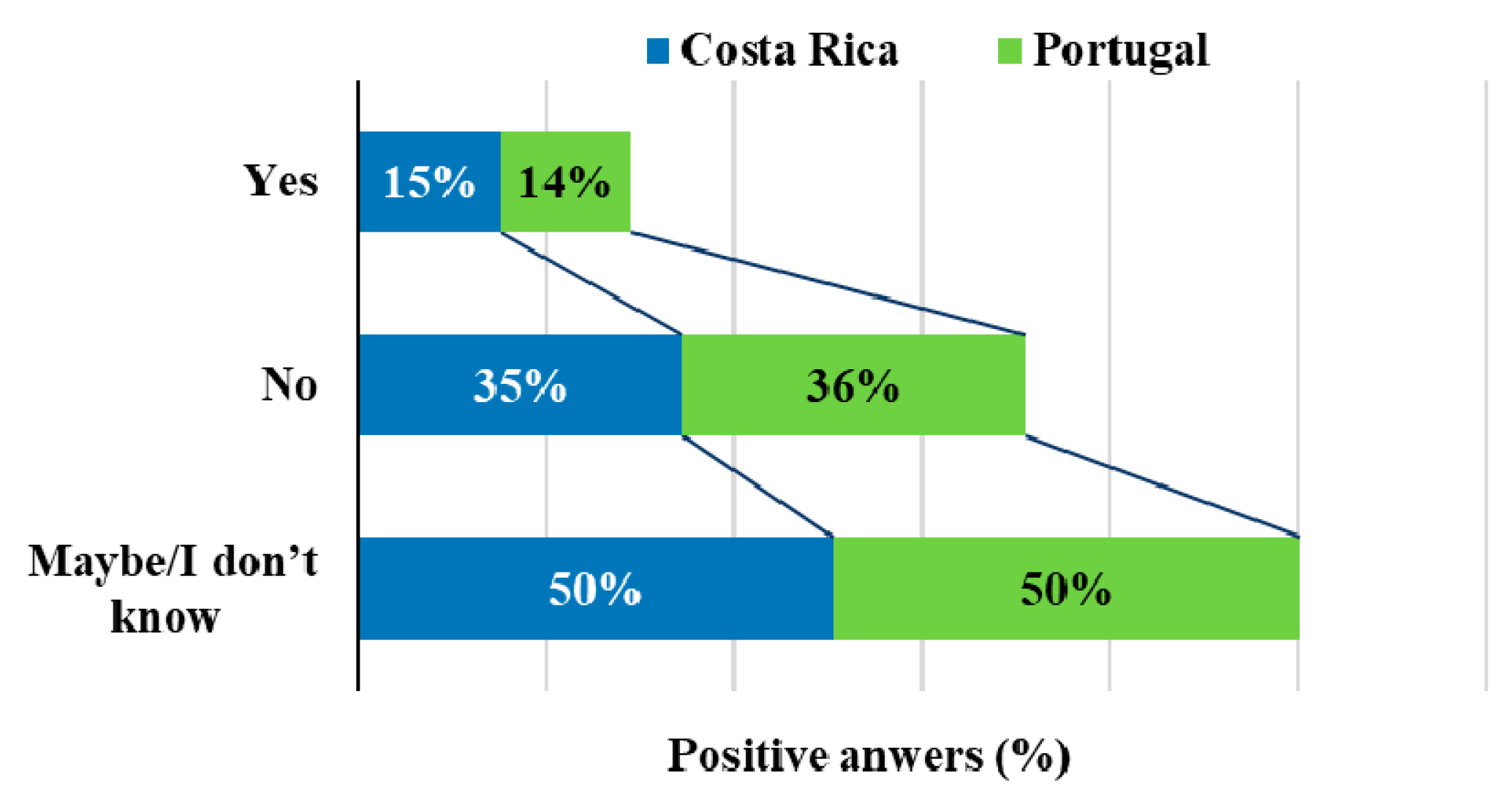
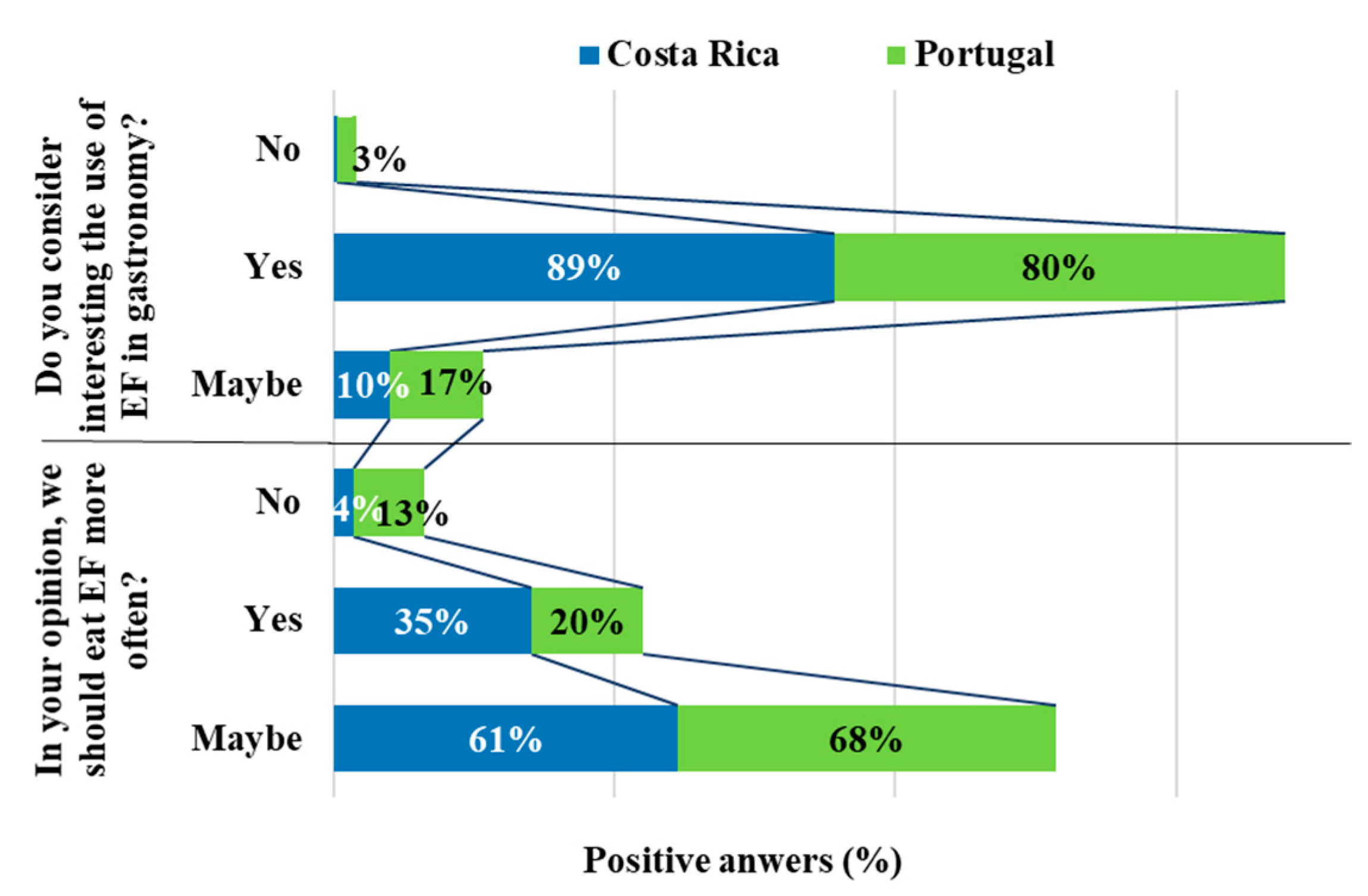
| Variable | Costa Rica | Portugal | Total (1) | |
|---|---|---|---|---|
| Dimension: N (%) | 139 (47.9) | 151 (52.1) | 290 (100) | |
| Age (2) (MV ± SD years) | 38 ± 12 | 41 ± 13 | 40 ± 13 | |
| Age group | Young adults (18–30 years) (%) | 30.2 | 23.8 | 26.9 |
| Middle aged adults (31–50 years) (%) | 52.6 | 53.0 | 52.7 | |
| Senior adults (51–65 years) (%) | 15.8 | 20.5 | 18.3 | |
| Elderly (≥66 years) (%) | 1.4 | 2.6 | 2.1 | |
| Sex | Women (%) | 62.6 | 80.8 | 72.1 |
| Men (%) | 37.4 | 19.2 | 27.9 | |
| Education level | Basic (%) | 2.9 | 3.3 | 3.1 |
| Secondary (%) | 12.2 | 15.2 | 13.8 | |
| University (%) | 84.9 | 81.5 | 83.1 | |
| Living environment | Urban (%) | 66.2 | 68.0 | 67.2 |
| Suburban (%) | 12.9 | 7.3 | 10.0 | |
| Rural (%) | 20.9 | 24.7 | 22.8 | |
| Professional Area | Costa Rica | Portugal | Total (1) | |||
|---|---|---|---|---|---|---|
| Yes (%) | No (%) | Yes (%) | No (%) | Yes (%) | No (%) | |
| Nutrition/Food | 17.3 | 82.7 | 58.0 | 42.0 | 38.4 | 61.6 |
| Agriculture | 31.2 | 68.8 | 29.3 | 70.7 | 30.2 | 69.8 |
| Hotels/Restaurants | 5.0 | 95.0 | 12.1 | 87.9 | 8.7 | 91.3 |
| Not related to any of the above | 43.5 | 56.5 | 38.3 | 61.7 | 47.0 | 53.0 |
| Question | Total (1) | Costa Rica | Portugal | CST (2) | CC (3) | ||
|---|---|---|---|---|---|---|---|
| χ2 | p | V | |||||
| Have you heard about EF? | Yes (%) | 86.9 | 76.3 | 96.7 | 26.530 | <0.0005 (5) | 0.302 |
| No (%) | 13.1 | 23.7 | 3.3 | ||||
| Do you think there is enough information about EF? | Yes (%) | 3.8 | 3.6 | 4.0 | 0.028 | 0.557 (5) | - |
| No (%) | 96.2 | 96.4 | 96.0 | ||||
| Do you think there are risks associated with consumption of EF? | Yes (%) | 35.2 | 27.4 | 42.4 | 7.342 | 0.025 | 0.159 |
| No (%) | 31.0 | 33.8 | 28.5 | ||||
| M (4) (%) | 33.8 | 38.8 | 29.1 | ||||
| Do you think toxicity is a risk? | Yes (%) | 83.8 | 71.2 | 93.5 | 12.237 | 0.001 (5) | 0.300 |
| No (%) | 16.2 | 28.8 | 6.5 | ||||
| Do you think pesticides are a risk? | Yes (%) | 80.9 | 68.3 | 91.8 | 12.105 | <0.0005 (5) | 0.298 |
| No (%) | 19.1 | 31.7 | 8.2 | ||||
| Do you think there are other risks? | Yes (%) | 50.5 | 39.6 | 58.7 | 3.995 | 0.035 | 0.190 |
| No (%) | 49.5 | 60.4 | 41.3 | ||||
| Question | Related (1) | Not Related (1) | CST (2) | CC (3) | ||
|---|---|---|---|---|---|---|
| χ2 | p | V | ||||
| Have you heard about EF? | Yes (%) | 94.7 | 22.2 | 17.901 | <0.0005 (5) | 0.250 |
| No (%) | 5.3 | 77.8 | ||||
| Do you think there is enough information about EF? | Yes (%) | 5.3 | 2.2 | 1.794 | 0.151 (5) | - |
| No (%) | 94.7 | 97.8 | ||||
| Do you think there are risks associated with consumption of EF? | Yes (%) | 46.7 | 22.2 | 19.234 | 0.442 | - |
| No (%) | 27.0 | 35.6 | ||||
| M (4) (%) | 26.3 | 42.2 | ||||
| Do you think toxicity is a risk? | Yes (%) | 86.7 | 77.8 | 1.738 | 0.142 (5) | - |
| No (%) | 16.3 | 22.2 | ||||
| Do you think pesticides are a risk? | Yes (%) | 80.5 | 81.3 | 0.012 | 0.552 (5) | - |
| No (%) | 19.5 | 18.7 | ||||
| Do you think there are other risks? | Yes (%) | 50.0 | 50.0 | 0.000 | 0.579 (5) | - |
| No (%) | 50.0 | 50.0 | ||||
| Questions | Country | Age Group | Sex | Living Environment | Education Level | |
|---|---|---|---|---|---|---|
| How did you eat the flowers? | In salads | ns | ns | ns | ns | ns |
| In starters | 0.0019 ** | ns | ns | ns | ns | |
| In jelly | ns | ns | ns | ns | ns | |
| As aroma intensifiers | ns | ns | ns | ns | ns | |
| Decoration and confection of dishes | ns | ns | 0.0307 * | ns | ns | |
| Others | 0.0232 * | ns | ns | ns | ns | |
| Which flowers have you already eaten? | Orchid | ns | ns | ns | ns | ns |
| Pansy | 0.0001 *** | ns | 0.0125 * | ns | ns | |
| Sunflower | ns | ns | ns | ns | ns | |
| Chamomile | ns | ns | ns | ns | ns | |
| Calendula | ns | ns | ns | ns | ns | |
| Pumpkin flower | 0.0405 * | ns | ns | 0.0007 *** | ns | |
| Rose | ns | ns | ns | 0.0209 * | ns | |
| Others | ns | ns | ns | ns | ns | |
| Frequency of consumption of EF? | 0.0021 ** | ns | ns | ns | 0.0199 * | |
| What motivates you to consume them? | Decoration | ns | 0.0287 * | ns | ns | ns |
| Taste | ns | ns | ns | ns | ns | |
| Aroma | ns | ns | ns | ns | ns | |
| Nutrition | ns | 0.0346 * | ns | ns | ns | |
| Antioxidant activity | ns | ns | ns | ns | ns | |
| Novelty | ns | ns | ns | ns | ns | |
| Other | ns | ns | ns | ns | ns | |
| If you consume EF, in what form? | Fresh | 0.0251 * | Δ | ns | ns | Δ |
| Cooked | 0.0053 ** | ns | ns | |||
| Other | ns | ns | ns | |||
| If you use EF, where do you buy them? | Supermarket | ns | Δ | ns | ns | Δ |
| Home cultivation | ns | ns | ns | |||
| Flower shop | ns | ns | ns | |||
| Collect in wild | ns | ns | ns | |||
| Other | ns | ns | 0.0051 ** | |||
| Is there enough information about EF? | ns | ns | 0.0396 * | ns | ns | |
| Risks associated with consumption of EF | Toxicity | ns | ns | ns | ns | Δ |
| Pesticides | 0.0055 ** | ns | 0.0032 ** | ns | ||
| Other | ns | ns | ns | ns | ||
| EF are easy to obtain? | ns | ns | ns | ns | ns | |
| In your opinion we should eat EF more often? | ns | ns | ns | ns | ns | |
© 2020 by the authors. Licensee MDPI, Basel, Switzerland. This article is an open access article distributed under the terms and conditions of the Creative Commons Attribution (CC BY) license (http://creativecommons.org/licenses/by/4.0/).
Share and Cite
P. F. Guiné, R.; Florença, S.G.; Villalobos Moya, K.; Anjos, O. Edible Flowers, Old Tradition or New Gastronomic Trend: A First Look at Consumption in Portugal versus Costa Rica. Foods 2020, 9, 977. https://doi.org/10.3390/foods9080977
P. F. Guiné R, Florença SG, Villalobos Moya K, Anjos O. Edible Flowers, Old Tradition or New Gastronomic Trend: A First Look at Consumption in Portugal versus Costa Rica. Foods. 2020; 9(8):977. https://doi.org/10.3390/foods9080977
Chicago/Turabian StyleP. F. Guiné, Raquel, Sofia G. Florença, Keylor Villalobos Moya, and Ofélia Anjos. 2020. "Edible Flowers, Old Tradition or New Gastronomic Trend: A First Look at Consumption in Portugal versus Costa Rica" Foods 9, no. 8: 977. https://doi.org/10.3390/foods9080977
APA StyleP. F. Guiné, R., Florença, S. G., Villalobos Moya, K., & Anjos, O. (2020). Edible Flowers, Old Tradition or New Gastronomic Trend: A First Look at Consumption in Portugal versus Costa Rica. Foods, 9(8), 977. https://doi.org/10.3390/foods9080977






